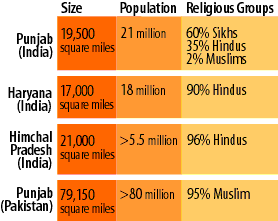 |
 |
|
|
Pick a Region:. . South Asia:. . Punjab
Physically, the Punjab is a large, flat plain of rich alluvial soil (see landuse map). The northern boundary of the Punjab is formed by the foothills of the Himalayas (the Pir Panjal range in Pakistan and the Shivalik Hills in India). The Indus River forms the western border, and the Yamuna River forms the eastern border. The region's five rivers--Jhelum, Chenab, Ravi, Beas, and Sutlej--join the Indus River at the southern extent of the region. In fact, the term Punjab comes from the Persian words "panj" (five) and "ab" (waters). You can see these land features in the physical map. Image courtesy of www.arttoday.com Politically, the Punjab has been divided between Pakistan and India since the partition of British India in 1947 (see History and Partition, 1947). Pakistan was awarded 62% of the Punjab. This portion of the Punjab became one of Pakistan's provinces. You can also see that India was awarded the remaining 38% of the Punjab (see 1947 map). In 1966, India's portion of the Punjab was divided into three areas: Punjab, Haryana, and Himchal Pradesh (see 1966 map). The northwest sections became the state of Punjab, the southeast area became the state of Haryana, and the hilly regions in the northeast went to the state of Himchal Pradesh. The borders for these three states still exist today. It is important to note that even though the Punjab region has been divided for political reasons, people use the historical term "Punjab" to refer to the alluvial plain occupied by both Pakistan and India. Its People 
In India, the state of Punjab represents only 1.7% of India's territory but holds 2.1% of India's entire population. As can be seen in the table above, Muslims make up only 2% of the population in India's Punjab state. However, when one considers that approximately 13% of India's total population is Muslim, and that India's Punjab borders "Muslim" Pakistan, it is easy to see how the 2% Muslim population is politically important. Therefore, keeping the Muslims content is important to keeping the peace in the Punjab as well as in India and Pakistan. In Pakistan, the province of Punjab makes up about 25% of Pakistan's territory and contains almost 60% of Pakistan's population. |
|
|
|
|
|
|
Privacy Statement and Copyright © 1999-2002 by Wheeling Jesuit University/Center for Educational Technologies®. All rights reserved. |
...